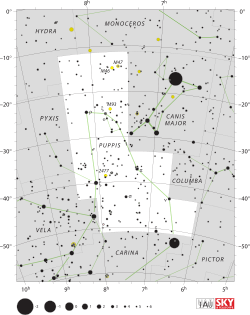Pi Puppis

| |
| Observation data Epoch J2000 Equinox J2000 | |
|---|---|
| Constellation | Puppis |
| Right ascension | 07h 17m 08.55678s[1] |
| Declination | −37° 05′ 50.8962″[1] |
| Apparent magnitude (V) | 2.733[2] |
| Characteristics | |
| Spectral type | K3 Ib[3] |
| U−B color index | +1.238[2] |
| B−V color index | +1.608[2] |
| Variable type | SRd[4] |
| Astrometry | |
| Radial velocity (Rv) | +15.8[5] km/s |
| Proper motion (μ) | RA: −10.05[1] mas/yr Dec.: +6.47[1] mas/yr |
| Parallax (π) | 4.04 ± 0.33[1] mas |
| Distance | 810 ± 70 ly (250 ± 20 pc) |
| Absolute magnitude (MV) | 4.5[6] |
| Details | |
| Mass | 11.7 ± 0.2[7] M☉ |
| Radius | 290 R☉ |
| Luminosity | 19,200[8] L☉ |
| Temperature | 3,990–4,055[9] K |
| Age | 20.0 ± 3.9[7] Myr |
| Other designations | |
Pi Puppis (Pi Pup, π Puppis, π Pup) is the second-brightest star in the southern constellation of Puppis. It has an apparent visual magnitude of 2.733,[2] so it can be viewed with the naked eye at night. Parallax measurements yield an estimated distance of roughly 810 light-years (250 parsecs) from the Earth.[1] This is a double star with a magnitude 6.86 companion at an angular separation of 0.72 arcsecond and a position angle of 148°.[11]
The spectrum of Pi Puppis matches a stellar classification of K3 Ib.[3] The Ib luminosity class indicates this a lower luminosity supergiant star that has consumed the hydrogen fuel at its core, evolved away from the main sequence, and expanded to about 290 times the Sun's radius. The effective temperature of the star's outer envelope is about 4,000 K,[9] which gives it the orange hue of a K-type star.[12] It is a semiregular variable star[4] that varies in apparent magnitude from a high of 2.70 down to 2.85.[13] Pi Puppis is the brightest star in the open cluster Collinder 135.[14]
Naming
In Chinese, 弧矢 (Hú Shǐ), meaning Bow and Arrow,[15] refers to an asterism consisting of π Puppis, δ Canis Majoris, η Canis Majoris, HD 63032, HD 65456, ο Puppis, k Puppis, ε Canis Majoris and κ Canis Majoris. Consequently, π Puppis itself is known as 弧矢九 (Hú Shǐ jiǔ, English: the Ninth Star of Bow and Arrow.)[16]
References
- 1 2 3 4 5 6 van Leeuwen, F. (November 2007), "Validation of the new Hipparcos reduction", Astronomy and Astrophysics, 474 (2): 653–664, arXiv:0708.1752
 , Bibcode:2007A&A...474..653V, doi:10.1051/0004-6361:20078357
, Bibcode:2007A&A...474..653V, doi:10.1051/0004-6361:20078357 - 1 2 3 4 Gutierrez-Moreno, Adelina; et al. (1966), "A System of photometric standards", Publ. Dept. Astron. Univ. Chile, Publicaciones Universidad de Chile, Department de Astronomy, 1: 1–17, Bibcode:1966PDAUC...1....1G
- 1 2 Houk, Nancy (1979), "Michigan catalogue of two-dimensional spectral types for the HD stars", Michigan Catalogue of Two-dimensional Spectral Types for the HD stars. Volume_3. Declinations -40_ƒ0 to -26_ƒ0, Ann Arbor, Michigan: Dept. of Astronomy, University of Michigan, 3, Bibcode:1982MSS...C03....0H
- 1 2 Kazarovets, E. V.; et al. (January 1999), "The 74th Special Name-list of Variable Stars", Information Bulletin on Variable Stars, 4659: 1, Bibcode:1999IBVS.4659....1K
- ↑ Evans, D. S. (June 20–24, 1966). "The Revision of the General Catalogue of Radial Velocities". In Batten, Alan Henry; Heard, John Frederick. Determination of Radial Velocities and their Applications, Proceedings from IAU Symposium no. 30. Determination of Radial Velocities and their Applications. 30. University of Toronto: International Astronomical Union. p. 57. Bibcode:1967IAUS...30...57E.
- ↑ Parsons, Sidney B. (2001). "A Large Spectral Class Dependence of the Wilson-Bappu Effect among Luminous Stars". The Publications of the Astronomical Society of the Pacific. 113 (780): 188. Bibcode:2001PASP..113..188P. doi:10.1086/318616.
- 1 2 Tetzlaff, N.; Neuhäuser, R.; Hohle, M. M. (January 2011), "A catalogue of young runaway Hipparcos stars within 3 kpc from the Sun", Monthly Notices of the Royal Astronomical Society, 410 (1): 190–200, arXiv:1007.4883
 , Bibcode:2011MNRAS.410..190T, doi:10.1111/j.1365-2966.2010.17434.x
, Bibcode:2011MNRAS.410..190T, doi:10.1111/j.1365-2966.2010.17434.x - ↑ Kaler, james B., "PI PUP (Pi Puppis)", Stars, University of Illinois, retrieved 2012-01-10
- 1 2 Pérez Martínez, M. Isabel; Schröder, K.-P.; Cuntz, M. (June 2011), "The basal chromospheric Mg II h+k flux of evolved stars: probing the energy dissipation of giant chromospheres", Monthly Notices of the Royal Astronomical Society, 414 (1): 418–427, arXiv:1102.4832
 , Bibcode:2011MNRAS.414..418P, doi:10.1111/j.1365-2966.2011.18421.x
, Bibcode:2011MNRAS.414..418P, doi:10.1111/j.1365-2966.2011.18421.x - ↑ "CCDM J07171-3706A -- Double or multiple star", SIMBAD, Centre de Données astronomiques de Strasbourg
- ↑ Fabricius, C.; Makarov, V. V. (April 2000), "Two-colour photometry for 9473 components of close Hipparcos double and multiple stars", Astronomy and Astrophysics, 356: 141–145, Bibcode:2000A&A...356..141F
- ↑ "The Colour of Stars", Australia Telescope, Outreach and Education, Commonwealth Scientific and Industrial Research Organisation, December 21, 2004, retrieved 2012-01-16
- ↑ Burnham, Robert (1978), Burnham's celestial handbook: an observer's guide to the universe beyond the solar system, Dover books explaining science, 3 (2nd ed.), Courier Dover Publications, p. 1499, ISBN 0-486-23673-0
- ↑ Eggen, O. J. (February 1983), "Six clusters in Puppis-Vela", Astronomical Journal, 88: 197–214, Bibcode:1983AJ.....88..197E, doi:10.1086/113306
- ↑ 弧矢 (Hú Shǐ) is westernized into Koo She. R.H. Allen had opinion that Koo She refers to the asterism including δ Velorum and ω Velorum. AEEA opinion is, δ Velorum is member of 天社 (Tiān Shè), meaning Celestial Earth God's Temple asterism and ω Velorum is not member of any asterisms. 天社 (Tiān Shè)is westernized into Tseen She and R.H.Allen used the term Tseen She for Chinese name of η Carinae. See Richard Hinckley Allen: Star Names — Their Lore and Meaning: Argo Navis and (Chinese) AEEA (Activities of Exhibition and Education in Astronomy) 天文教育資訊網 2006 年 7 月 17 日.
- ↑ (Chinese) AEEA (Activities of Exhibition and Education in Astronomy) 天文教育資訊網 2006 年 7 月 16 日